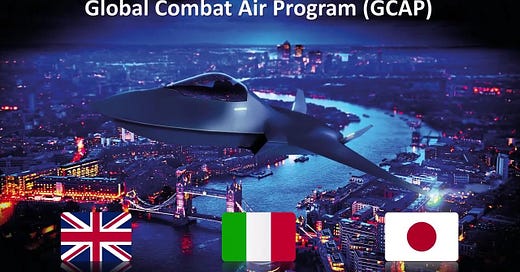At almost every defence-related forum I've attended this year, people have raised the future of the Global Combat Air Programme (GCAP). This is a trilateral venture between the UK, Japan and Italy to create a 6th Generation combat aircraft.
It is expensive, won't be flown until the middle of the next decade and the threat it needs to counter is evolving rapidly due to technological change.
Given the Strategic Defence Review (SDR) is supposed to conduct a root-and-branch assessment of UK capabilities, shaping them to the threat of Russian aggression, there is a chance that it will face submissions calling for GCAP to be delayed or scrapped.
Last month the IISS published a comprehensive report on GCAP, making the case for keeping it. Any decision to withdraw, it said, would risk:
"loss of military capability and inflict grievous damage on the UK defence- aerospace sector. Relations with Italy and Japan would be marred and UK sovereign design capability would at best be eroded with the industrial harm felt throughout the defence-aerospace supply chain."
This week Air Marshal Greg Bagwell, a retired former RAF commander who now heads up the Air and Space Association, made a convincing proposal: to freeze instead the UK's purchase of the F-35B stealth fighter at 48 airframes and resume buying the Eurofighter Typhoon, whose latest version - the Tranche 4 - is currently being produced for Germany, effectively betting that GCAP will come good sooner rather than later.
In this edition of Conflict & Democracy - written as always from open source info and for the layperson not the defence specialist - I will lay out the wider arguments.
What do have today?
The RAF operates 137 Typhoons and 31 F-35Bs, with 30 of the first batch of Typhoons set to retire, and another 17 of the F-35Bs on order.
The Typhoon is a highly-capable 4th generation multirole aircraft that can strike targets, perform air superiority and reconnaissance missions with a variety of weapons, and will be the backbone of the RAF in any conflict with Russia in the near future. But it is not stealthy.
Scaling the F-35 purchase to its intended 138 aircraft gives the UK a phenomenal short-range stealth fighter but the downsides have been well discussed:
Strategic: the F-35 is not a "sovereign" capability, because the USA controls the pipeline and the software, and the F-35 is basically (as one flyer put it to me this week) a piece of flying software.
Operational: the F-35 has a short range and the need for stealth means it can't carry a big payload, and indeed currently has no weapons that can do ground attack or suppress enemy air defences.
Financial: there is no money budgeted to buy more than the 48 F-35s currently ordered.
So, says Bagwell, we should cap the F-35 programme at 48, reinvest in Typhoon and use the saving to press ahead with GCAP.
The arguments for GCAP are that it (a) will be a capability we can have sovereign control over; (b) secures the future of the UK aerospace workforce and intellectual property; (c) it will be superior to anything the adversary can put into the air, including China in the short-term.
But here's where it gets tricky. There's no clear budget for GCAP, beyond the £2bn development money already spent (with anticipated but not yet budgeted £12bn over the next 10 years). And there are a lot of solid arguments for delaying it or scrapping it, given our other priorities and shortage of cash.
But the real problem is this: the GCAP debate has become a repository for multiple, systemic dilemmas in UK defence - and what the SDR needs to do is take a holistic view of the whole threat-capability-sovereignty complex.
Instead of "it's impossible to cancel GCAP because…" its supporters should reframe the debate around why we need it, and therefore what we are prepared to pay, or scrap, in order to afford it. Treating it as an air power issue alone is to approach the problem inside out.
From the questions enumerated below it should be possible to construct something like a decision tree for resolving the problem of GCAP. At the end of this article I offer a draft of such a decision tree.
Nine big questions…
The first question the UK faces is: which adversary do we expect to fight and when, and what forces do we need to deter them from aggression?
The obvious answer is Russia and the danger is that if it defeats Ukraine, it might quickly rearm and launch an aggression against a NATO ally, requiring the UK fight sometime before 2030.
However, there are subsidiary threats, the RAF's Typhoon force is key to countering them. In addition to the Quick Reaction Alerts it performs against ingressing Russian bombers, around once a month on current figures, it has four Tranche 1 Typhoons on standby in the Falkands.
It has conducted more than 10,000 sorties against ISIS in the Middle East. Even though Operation SHADER, the anti-ISIS mission, is shutting down, Typhoons were in action against both of this year's missile attacks on Israel.
In the longer-term the UK may need to take part in deterring Chinese aggression in the Pacific, for which a whole different force structure and capability mix would be needed.
Question Two should be: what force does the UK need to deter the Russian threat and keep NATO's collective deterrence credible?
It is axiomatic that the UK needs to be capable of defending its own airspace against Russian bombers, which the Typhoon has proved capable of for years. The UK also needs to be able to conduct air superiority operations for NATO, including to achieve air superiority over Russia, and to strike the adversary deep inside its own territory.
Keep reading with a 7-day free trial
Subscribe to Conflict & Democracy to keep reading this post and get 7 days of free access to the full post archives.




